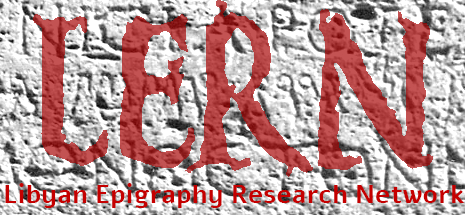IRT 1952
J.M. Reynolds and J.B. Ward-Perkins. In collaboration with Salvatore Aurigemma, Renato Bartoccini, Giacomo Caputo, Richard Goodchild and Pietro Romanelli. Inscriptions of Roman Tripolitania. Published for the British School at Rome, 1952.
John Ward-Perkins (Wikidata) and Joyce Reynolds (Wikidata), based in the British School at Rome (BSR), with the help of Richard Goodchild (Wikidata) worked in Libya, collecting and recording antiquities, particularly inscriptions, between 1947 and 1952. Ward-Perkins provided a large collection of photographs; Reynolds prepared the inscribed texts for publication. In this they were helped by and included contributions from several Italian archaeologists, particularly Salvatore Aurigemma (Wikidata), Renato Bartoccini (VIAF), Giacomo Caputo (Wikidata), and Pietro Romanelli (Wikidata). The resultant volume was published by the British School at Rome in 1952, presenting numbers 1-973, and 30 plates of photographs: the remainder of the photographs were available for consultation at the British School.
IRT 2009
Inscriptions of Roman Tripolitania, by J.M. Reynolds and J.B. Ward-Perkins, enhanced electronic reissue by Gabriel Bodard and Charlotte Roueché (2009). ISBN 978-1-897747-23-0. Available: http://inslib.kcl.ac.uk/irt2009/.
In the early 2000s Michael Greenhalgh (Australian National University, VIAF) agreed with the Director of the British School at Rome, Andrew Wallace-Hadrill (Wikidata) that it would be desirable to create an online publication of IRT, allowing for full illustration. At that time such publications were not yet common: Greenhalgh produced a prototype version, and a team at the BSR including Raphael Helman, Sophy Downes, Raphael Cormack, and Jo Wallace-Hadrill, worked to develop this. In 2008 they entered into partnership with an international team to publish the work in EpiDoc: Gabriel Bodard (Wikidata) Charlotte Roueché (Wikidata) and Hafed Walda, all at King’s College London, and Tom Elliott (ORCID), Institute for the Study of the Ancient World at NYU. Some 20 further texts, published by Joyce Reynolds in 1955, were added, and Reynolds provided English translations of every text; Valerie Scott, the Librarian of the BSR, provided the images; Hafed Walda researched and provided the geodata, which were subsequently used to build the Heritage Gazetteer of Libya. For a full account of the many contributors see Project team. IRT2009 was published online in 2009: https://inslib.kcl.ac.uk/irt2009/.
IRT 2021
Inscriptions of Roman Tripolitania, by J.M. Reynolds, C.M. Roueché, G. Bodard, C. Barron and others (2021). ISBN 978-1-912466-25-2. Available: http://irt2021.inslib.kcl.ac.uk.
In 2021 Charlotte Roueché received a grant from the Society of Libyan Studies to prepare an updated version of IRT, using the EFES editing platform which had been used for the Inscriptions of Roman Cyrenaica (2020): https://ircyr2020.inslib.kcl.ac.uk. Roueché continued and standardised the editing, adding further texts and references, bibliography and translations.
- Irene Vagionakis (ORCID) established and developed the basic architecture and design of the site; she organised the conversion of further texts from the Epigraphische Datenbank Heidelberg.
- Gabriel Bodard worked with Roueché and Vagionakis on the editing and standardisation of texts, and use of EpiDoc standards; he also worked on the conversion of the Bu-Njem ostraca from papyri.info, and on their edition and translation.
- Caroline Barron (Wikidata) added the Punic to all the multi-lingual texts, edited and translated a group of texts from Sirte. Barron, Bodard and Roueché worked on translating the ostraca from Bu-Njem.
- Usama Gad (ORCID) contributed to the translation of the Bu-Njem ostraca.
- Alessandra Giovenco (BSR), assisted by Roberta Cascino, curated the enrichment of the BSR photographic collection, and the interoperability of the resources.
- For the lemmatisation of the Latin and Greek texts Vagionakis and Roueché worked with Deucalion, with help from Thibault Clerice (ORCID)
In summer 2020 the first version of the publication was mounted online, and shared with interested scholars. As a result we received generous and important contributions, from Francesca Bigi (VIAF: drawings), Catherine Dobias-Lalou (VIAF: advice on Greek verse texts), Philip Kenrick (Wikidata: photographs), Robert Kerr (VIAF: advice on Neo-Punic and Latino-Punic texts), Michael Mackensen (Wikidata: comments and photographs), Ignazio Tantillo (Wikidata: comments and photographs). We have been able to draw on previous editions and translations by these and many other scholars.
The collection is published with an open licence, allowing its reuse for academic purposes and public benefit (CC-BY-NC-SA); we very much hope that colleagues will use it in that way, and so build on our work as we have built on the work of others. For the teams developing EFES see GitHub. IRT 2009 (now converted to a static site) and IRT 2021 are hosted at King’s Digital Lab, King’s College London.
Future Plans
Future editions of IRT will be published by a team led by Caroline Barron.
